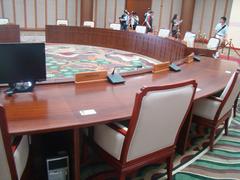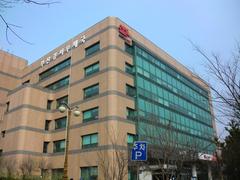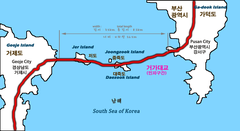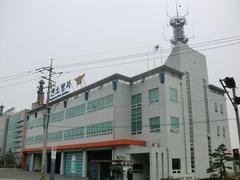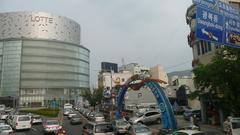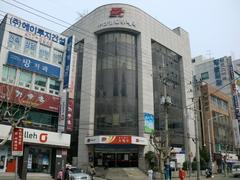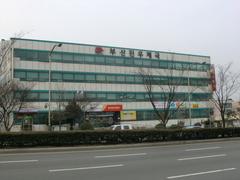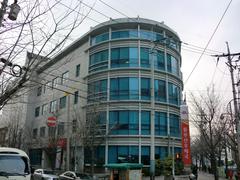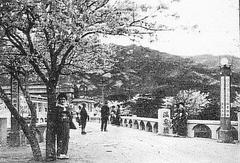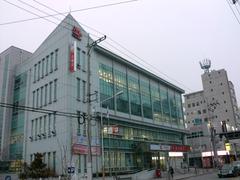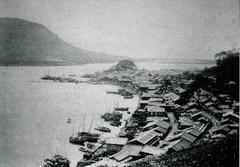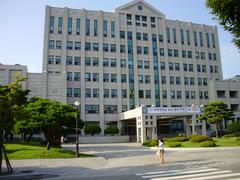Deokpo Station: Visiting Hours, Tickets, and Attractions in Busan
Date: 04/07/2025
Introduction
Situated in the heart of Sasang-gu, western Busan, Deokpo Station is a pivotal stop on Busan Metro Line 2. Beyond being a key transit point, it offers travelers an authentic gateway into local life and the historical evolution of South Korea’s second-largest city. With a seamless blend of efficient transportation, local culture, and proximity to significant attractions, Deokpo Station is ideal for those seeking to experience Busan off the typical tourist track. This guide provides comprehensive details on visiting hours, ticketing, local amenities, accessibility, and nearby points of interest, paired with essential travel tips for maximizing your Busan journey (travel80.com; bontraveler.com; Roadaffair).
Table of Contents
- Historical Evolution of Busan and Deokpo
- Deokpo Station: Hours, Ticketing, and Accessibility
- Cultural Significance and Nearby Attractions
- Practical Travel Tips
- Frequently Asked Questions (FAQ)
- Visuals and Media Recommendations
- Conclusion and Travel Recommendations
- References
Historical Evolution of Busan and Deokpo
From Ancient Port to Modern Metropolis
Busan’s origins trace back to the Three Kingdoms period, when it served as a vital maritime trading hub due to its strategic coastal location (travel80.com). Over centuries, the city evolved as a center for commerce and cultural exchange, especially with Japan and China. The Goryeo and Joseon dynasties further cemented its port city status, and Japanese colonial influence in the late 19th and early 20th centuries led to rapid urban growth and infrastructural modernization.
During the Korean War, Busan became a sanctuary for refugees and the temporary capital of South Korea, which spurred a massive population surge and development of western districts like Sasang-gu. In the latter 20th century, expansion and the introduction of Busan Metro Line 2 integrated Deokpo into the city’s growing urban network, marking its transformation from a peripheral area to a bustling neighborhood.
Deokpo Station: Hours, Ticketing, and Accessibility
Operating Hours
Deokpo Station operates daily, generally from 5:30 AM to midnight, aligning with Busan Metro Line 2’s schedule. Trains run every 5–10 minutes during peak times (Namu Wiki).
Ticketing
- Single-Journey Tickets: Purchase via vending machines (cash/credit accepted).
- IC Cards: Use T-money, Cashbee, Hanaro, or Korea Tour Card for convenience, discounted transfers, and seamless travel across buses and subways (Roadaffair).
- Fares: Range from KRW 1,300 to 1,800 (approx. USD 1–1.40), depending on distance.
- Mobile Payments: Samsung Pay, NFC-enabled services, and contactless readers are supported.
Accessibility Features
- Barrier-Free Access: Elevators, ramps, tactile paving, and wide corridors ensure easy navigation for all, including wheelchair users.
- Signage: Bilingual (Korean/English), with some Japanese and Chinese support.
- Restrooms: Accessible restrooms and baby care facilities are available.
- Staff Assistance: Trained staff and emergency intercoms support passengers with special needs.
Cultural Significance and Nearby Attractions
Neighborhood Character
Deokpo’s surroundings reflect the daily life of Busan’s working and middle-class residents. The area is characterized by traditional markets, local eateries, and community centers, showcasing a blend of heritage and modern urban development.
Notable Nearby Attractions
- Gamcheon Culture Village: A vibrant hillside community famed for colorful homes and street art, originally settled by war refugees (travel80.com). Open 9:00 AM–6:00 PM.
- Jagalchi Fish Market: Korea’s largest seafood market, bustling with activity especially in the mornings (bontraveler.com).
- Yongdusan Park & Busan Tower: Offering panoramic views and cultural events. Busan Tower is open 10:00 AM–10:00 PM (bontraveler.com).
- Samnak Ecological Park: A riverside park ideal for birdwatching, cycling, and seasonal flower festivals.
- Seomyeon, Gwangalli Beach, Haeundae Beach, and Centum City: All accessible within 20–30 minutes by subway (HungryPursuit).
Local Markets and Dining
Experience Busan’s culinary traditions in Deokpo’s modest restaurants and pojangmacha (street food tents). Popular dishes include milmyeon (cold wheat noodles), dwaeji gukbap (pork rice soup), Korean BBQ, seafood pancakes, and local fish cakes.
Practical Travel Tips
- Plan Ahead: Use Naver Maps, KakaoMap, or the Barrier-Free app for navigation and station information.
- Travel Cards: Opt for rechargeable IC cards for discounted, convenient travel.
- Peak Times: Avoid rush hours (7:00–9:00 AM, 5:00–7:00 PM) for a more relaxed experience.
- Cash: Carry some cash (KRW 50,000–100,000) for small vendors.
- Language: Translation apps such as Papago are useful; most signage is bilingual.
- Safety: Deokpo is safe and tourist-friendly, with CCTV, on-site staff, and a low crime rate.
- Seasonal Advice: Spring and autumn offer the best weather and host major local festivals (KoreaToDo).
Frequently Asked Questions (FAQ)
Q: What are Deokpo Station’s operating hours?
A: About 5:30 AM to midnight daily.
Q: How do I buy tickets?
A: Use vending machines for single rides or rechargeable IC cards (T-money, Cashbee).
Q: Is the station accessible?
A: Yes, with elevators, tactile paving, accessible restrooms, and staff assistance.
Q: Are there guided tours?
A: Some local tours include Deokpo for cultural insights, though the station itself is not a tourist landmark.
Q: What are nearby attractions?
A: Gamcheon Culture Village, Jagalchi Fish Market, Yongdusan Park, Samnak Ecological Park, and major beaches.
Q: Are there amenities for families?
A: Yes, including baby care facilities, priority seating, and accessible restrooms.
Visuals and Media Recommendations
- Photos: Include images of Deokpo Station’s entrance, local markets, street food stalls, and nearby parks.
- Alt Tags: Use descriptive tags such as “Deokpo Station entrance Busan,” “Traditional market near Deokpo Station,” and “Beomeosa Temple Busan historical site.”
- Virtual Tours and Maps: Interactive resources are available on the Busan Metro website and Visit Korea.
Conclusion and Travel Recommendations
Deokpo Station is more than a metro stop—it’s a vibrant access point to Busan’s authentic neighborhoods and living history. With its comprehensive facilities, accessible design, and strategic location, it’s ideal for both daily commuters and curious travelers. Visitors can enjoy the unique blend of tradition and modernity found in local markets, eateries, and parks, while benefiting from efficient connectivity to Busan’s top attractions.
For a fulfilling visit:
- Travel during off-peak times.
- Savor local dishes and support neighborhood markets.
- Use IC cards for convenience.
- Respect local customs and public spaces.
- Consult official resources and mobile apps for the latest updates.
Plan your journey with confidence and immerse yourself in the layers of history, culture, and daily life that define Busan’s western districts.
For further travel guides, download the Audiala app and follow our social media channels for updates and tips.
References
- Visiting Deokpo Station: History, Tickets, and Exploring Busan’s Historical Sites (travel80.com)
- Deokpo Station Visiting Hours, Tickets & Local Attractions in Busan (Roadaffair)
- Deokpo Station Accessibility, Ticketing & Visitor Guide – Busan Metro Line 2 (Busan Metro Official)
- Exploring Deokpo Station: Visiting Hours, Local Attractions, and Busan Historical Sites (GoTravelTipster)
- Busan Tourism History (travelsetu.com)
- Busan Itinerary and Attractions (bontraveler.com)
- Top 16 Attractions to Visit in Busan (Stars and Stripes)
- 15 Things to Do in Busan (HungryPursuit)
- Top Festivals in Busan (KoreaToDo)

